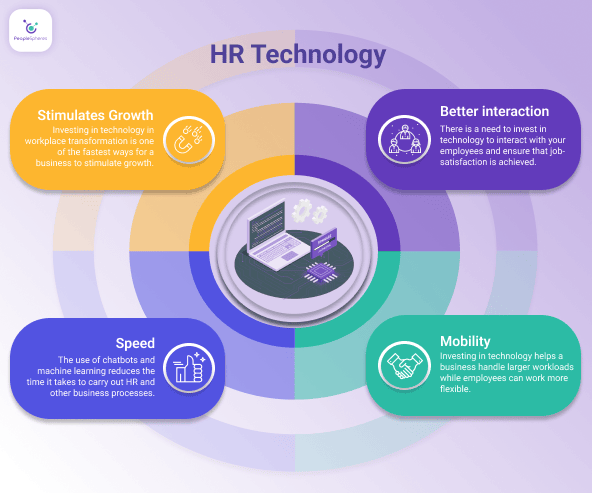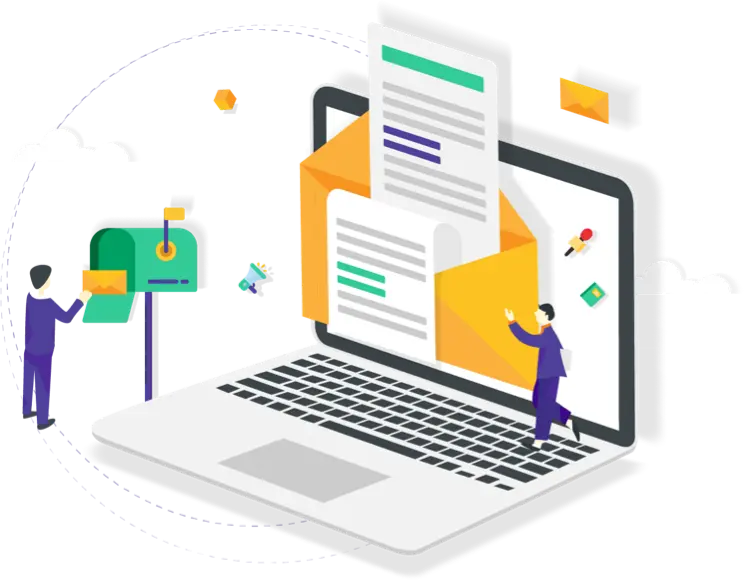-640x380.jpg)
A lot has changed in our workplaces in recent times, thanks to technological advances and the onset of artificial intelligence and robots in the digital age. Disruptive technological change is shaping the future of the workforce, ranging from how work is done to the organization and design of employees in the workplace. All this has been done to align the business objectives and transform the workplace to meet business goals. So, what does the future workplace looks like and what is workplace transformation?
Workplace transformation is the process of rethinking and redesigning workspaces to meet the always-evolving technology, fuel innovation, and attract employees back to work all while fostering the organizational culture. This can be a weakness in the future as companies are not focusing on this subject. In a study by Gartner, it was found that:
49% of HR leaders say they do not have an explicit future of work strategy
Gartner, 2022
Related articles:
Workplace Trends Every Organization Should Know
Ultimate List of HR Influencers to Follow in 2024
What Does the Future of Work Look Like?
The future of work is here and many of us are already working in a modern workplace. If you are an HR manager, you need to embrace workplace transformation to become a part of the future of work. This includes both employee development of the labor force and leveraging disruptions in a rapidly changing technology era.
As accelerating technological advancements are changing the world of work, all HR professionals need to ensure that they are changing the way how they perform business processes accordingly and that their workforce has the right competencies and skills for the future. Without adaptation, your business will lose competitiveness in a highly competitive market.
Your workplace can be transformed to support the future of HR in many ways. Some are:
- Implementing digital-technology
- Consider a flexible work model, either remote work or a hybrid working model
- Adopting new technology, such as AI systems with robotics implemented
- Redesigning the office space and work arrangements to ensure efficiency in the line of production and training
- Upskilling your workforce with knowledge workers based on recent trends to gain new skills and experience needed to support the future of work
- Prioritize equality, diversity, inclusion, and transparency
- Perform HR analytics and learn how to analyze big-data
- Prioritize employee benefits, well-being, and work-life balance
These are a few transformation strategies that will help you adapt to workplace transformation and make your business more sustainable in the work environment. Following these tips will be a step in the right direction in order to prepare for the future workplace and follow along with the disruption of digital technologies.
The most recent workplace trends are based on changes in the workplace and workforce trends such as working from home and not necessarily needing to be present in the office to get work done. Also, emerging technologies are changing ways of working. As work has become more technology-oriented, the need to process work manually has been been removed in many cases. In a Mercer study, it was stated that:
Nearly half of employees want hybrid or remote work in 2022, women more so than men. Even more telling is that one in three employees would be willing to forego a pay increase in return for more control over their work schedule (significantly higher for technology sector employees at 43%). But in its current form, working and managing remotely still feels like a struggle.
Mercer
The nature of workplace transformation has constantly been reshaped by the following factors:
- Advancement in high-performing technology
- Workforce development
- Globalization and the digital economy
- The unprecedented growth of SaaS applications
- A shift from traditional business models
- The need to increase production efficiency while reducing the overhead cost
The Future of HCM Technology
Human capital management (HCM) refers to how a business manages its employees and technologies that execute and manage its HR strategy. Technologies incorporated in HCM typically support and automates areas within HR management such as talent management, time and attendance, payroll, onboarding, compensation management, and more. The human resources functions are consolidated into an HCM cloud solution, which is a unified system that serves as a self-service for employees.
Currently, there is a functionality gap in the HCM technology. The solutions are not responsive and flexible enough and about 25 percent of companies need to supplement their systems with additive software to fulfill their requirements.
The future of HCM technology is expected to address the current functionality gap and support the future workforce. The new solutions are expected to:
1. Be adaptable to regional and industry-specific requirements
2. Come equipped with pre-built connectors and third-party application integration capabilities
3. Provide control over and customization of connectors between third-party applications
The Future of HRIS
When looking at the future of HRIS, one trend is clear: the HR application framework. The HR world is recognizing the need for future work, where employee and customer expectations have found the answer to composable applications for HRIS. This is not a one-time occurrence but seems to align with technological advancements and long-term future expectations.
Composable applications for HRIS allow businesses to innovate and adapt based on a modular model and allow them to quickly make changes based on current trends and needs. The flexibility and customization of composable applications are one of the reasons why it is quickly gaining popularity, not only within the HR department. When looking for a composable solution for HRIS, look for these key components:
1. Business applications
2. User experience
3. Applications composition platform
4. Data hub
Digital Workplace Transformation
Recently we are seeing trends such as remote working for more occupations, an influx of technology adoption that is increasing daily, and the agility of AI technologies. All these changes are pointing to a fourth industrial revolution in the 21st century, which will be spearheaded by digitization. So, there is a need for companies to take up workplace transformation and shift the workplace into a digital one. Here are some ideas you can adopt to attain a new digital workplace:
Artificial Intelligence in HR
As the workplace continues to evolve, artificial intelligence is rapidly reshaping how HR teams operate—bringing both efficiency and strategic value to the table.
One of the most visible shifts is in AI content creation for HR. AI tools now assist in drafting job descriptions, interview guides, internal announcements, and onboarding materials. This allows HR professionals to focus on refining messages rather than writing from scratch. When used thoughtfully, AI-generated content can speed up workflows while still reflecting the company’s tone and values.
Beyond content, AI plays a powerful role in data analysis. It can sift through large volumes of employee data to uncover trends, highlight skill gaps, identify high-potential talent, and even forecast turnover risks. These insights help HR make more informed, proactive decisions.
AI is also changing the way HR communicates. Chatbots and generative AI tools support real-time responses to employee queries, automate FAQs, and personalize interactions—enhancing the employee experience and reducing administrative burden.
However, as AI becomes more integrated into HR processes, it’s critical to maintain human oversight. Transparency, ethical use, and bias awareness must remain at the forefront. The best results come from a balance: letting AI handle the heavy lifting while humans provide the empathy, judgment, and nuance that technology can’t replicate.
Advanced security capabilities
With workers working remotely, you will need to improve your cybersecurity. Some employees access sensitive information regarding the company on a daily basis which puts your data at risk. If you have unprotected servers, you have a high-risk of your data falling into the wrong hands.
Chatbots
A successful digital workspace should use AI chatbots which make it easy for workers to access the information they need. This ease of access to the company’s information and documents through the intranet can be made possible through their phones or electronic devices as well.
Involve the workers in decision-making
A digital workspace requires two-way communication and for you to collaborate with staffing. Workers should be included when making decisions concerning various digital transformations and business initiatives. There should be a good communication channel between the workforce and their management teams in a successful digital workspace.
The younger generations also bring changes in the workforce regarding communication. Open communication is specifically appreciated by Millennials and Gen Z as they have a different mindset for workplace culture and work life. The workforce of the future tends to thrive better when the business value of the company is more centric to the employees and having open communication about decisions. This should be taken into account as it will increase engagement which will ultimately be a key asset of the transformation journey.
Is a Technology Investment Needed for Workplace Transformation?
As a business, investing in HR technology can be a good thing for the company to profit, for example, you can use technology to automate the planning of day-to-day work schedules. Here are some reasons why investing in technology can be worth it:
Stimulates Growth
Technology is impacting growth and development in the workplace. Investing in technology in workplace transformation is one of the fastest ways for a business to stimulate growth. Investing in technology will give your business the ability to compete with competitors in many areas thanks to the efficiency and speed it can provide.
Better Interaction
Businesses have shifted online, and employees expect to be able to access everything they need online. There is a need to invest in technology to interact with your employees and ensure that job-satisfaction is achieved. This can be seen as companies are being more data-driven and taking this digital strategy to adapt better to their business leaders’ goals.
Mobility
Investing in technology helps a business handle larger workloads; through cloud computing and SaaS technologies, employees can work from home without necessarily being at work. These perks will make daily life easier and will have an enablement of putting in the time to drive key goals.
Speed
These technology methodologies in this new digital business reduce the time taken by the workers to complete tasks. This means work can be done faster and more successfully. This is one of the greatest benefits of workplace transformation using digitalization. The use of chatbots and machine learning reduces the time it takes to carry out HR and other business processes.
In conclusion, a business should invest in the right technology and digitize its workforce as the future shifts toward technology.

Improving Employee Engagement with Workplace Transformation
Employee engagement can describe both the quantitative and qualitative aspects. It also means strengthening the relationship between the employee and the employer. Engagement is always essential to a business; through it, a business will retain the most productive staff, and enhance a company culture while still engaging and maintaining success.
So how does a business go about engaging its employees through workplace transformation? The following are some of how a company can successfully engage its employees:
- Empowering is done by giving everyone the relevant additional training to handle trends in the future of work like data management, cloud-based solutions, information systems, etc.
- Recognize top performers and have a system to reward them. As a manager, you should take time to notice and reward the efforts of top talent. This goes a long way in motivating them.
- Plan company outings. This will help break the monotony associated with the workplace, giving a change of environment. This allows everyone to engage with their colleagues and think of new ideas to provide the business with a competitive edge in the industry.
- Conduct employee engagement surveys. This will help with the interaction between the management and the workforce, and it will give employees a voice. It is important to listen to and understand needs and desires at your company.
Always engage with your employees, as they are the primary tool that will ensure that the business will attain workplace transformation soon enough.
Boosting HR and Productivity
The HR department in any organization works hand in hand with the employee to attain the business goals, so a boost in one means that the other will be boosted eventually and vice versa. HR effectiveness can be measured by taking into account and analyzing the following workplace transformation factors: employee retention and employee satisfaction.
Employee retention
When employees are satisfied with the workplace, the HR department is doing something right. This means they are more likely to stay. Not only does this help keep your retention rates low it also reduced recruiting and retraining costs.
Employee satisfaction
Satisfied employees mean that the HR department is doing something right and is focused on productivity. A satisfied workforce is a key to the digital transformation of the business. Satisfaction can be measured through surveys or regular feedback.
Here are a couple of ways to ensure that well-being and morale are boosted:
- Support flexible working. Employees that work remotely can access information remotely through cloud computing and SaaS technologies.
- Equip the department with the right technology. Machine learning, cloud-based systems, and HR ecosystems are among the many available trending technologies. A business can leverage these technologies to enhance the employee experience.
In a report by PwC “HR Tech Survey 2022“, it was documented that:
Companies were able to improve productivity by 86% and increase employment engagement by 84% through the deployment of cloud HR. This solution is now being implemented more and more as technology innovation is now becoming the hot topic every company is implementing.
PWC
Change Management
Workplace transformation can mean a lot of change for your company. Not only do you introduce new tools, but you are also transforming the workplace into a digital workplace, incorporating new business models and modernizing the workplace. Because of this, there is a need to put in place a good change management strategy that will help the workers and the business transition into new ways of doing things.
Change cannot be implemented all at once and requires step-by-step integration. There must be time allocated for the employees to get used to and embrace the changing factors in the working environment. Be it new business models, new technologies, or IT infrastructure, the workers should be given time to familiarize themselves with the change and understand its benefits.
Layout the needs and write a plan
When integrating change, there should be a well-detailed plan outlining the needs that the changes will fulfill. A plan should stipulate the incremental steps that will be taken to implement the change as abrupt change can hurt the business.
The plan should contain the obstacles that will hinder the change and ways to overcome the challenges. It should also lay out the goals to be achieved and the time they will be completed. Lastly, the plan should have a post-implementation evaluation to follow up after the change has been implemented.
Involve your employees when making a change
Employees are at the forefront of implementing change, and they should be involved when decisions to make a change affecting them are being discussed. For instance, when it comes to the digital transformation of the workplace, everyone should have a voice on how they want it done as they are the ones who will be affected directly in the implementation of the changes.
Anticipate all possible outcomes
Change can either have a positive or negative effect on the business, and there should be a plan in place in case the change is negative or is not received well by staff members. For instance, the digitalization of the workplace might not sit well with senior teams. Precautions should be taken to ensure that they have a smooth transition and they are confident moving forward with the introduction of new technologies.
Final Take Away
In general, change is inevitable, and whether we like it or not, there must be change as technology is constantly shifting towards modernization and the old ways of doing things are becoming obsolete. One way or the other, change must happen, and a business should train its employees adequately and prepare them for these changes.
Want to find out how PeopleSpheres is following the current trends in HR management?
Read our first carbon footprint assessment.


-360x360.jpg)

-666x380.jpg)